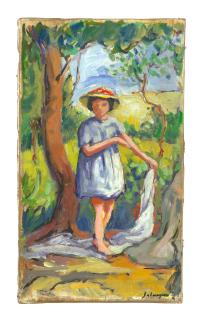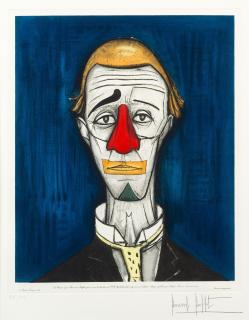Henri Lebasque Champigné 1865 - 1937 Le Cannet
The artist Henri Lebasque
- French Post-Impressionist painter with Fauvist influences.
- Co-founder of the Salon d'Automne in Paris, which paved the way for the Fauvist movement.
- Admired as a »painter of joy and light«.
French Post-Impressionist Henri Lebasque went down in art history as the »painter of joy and light« among his admirers. Yet he never achieved the fame of Claude Monet or similar contemporaries. Lebasque was born in 1865 in Champigné, a commune in northwestern France. He studied at the Ecole des Beaux Arts in Paris beginning in 1885, and after graduating, he joined the studio of the artist Leon Bonnat.
Lebasque regularly exhibited at the Paris Salon and was in contact with young contemporaries such as Edouard Vuillard and Pierre Bonnard, founders of the Nabis and the Intimists. Lebasque was also involved in the founding of the Salon d'Automne at the Petit Palais in Paris (1903), alongside artists such as Henri Matisse, and is thus also associated with Fauvism.
In 1912, the Salon d'Automne featured an exhibition by the group Les Fauves, which laid the foundation for the avant-garde movement. The event motivated Lebasque to make his own forms and colors appear more subtle by approaching the flatness of Fauvism. From 1924, the Post-Impressionist lived in Le Cannet, a commune north of Cannes. He spent a lot of time there with his artist friend Bonnard, and they conducted painting studies together.
In 1937, Lebasque died at his self-imposed home in the south of France, about a month before his 72nd birthday. He tended to fade into the background compared to his contemporaries. Twenty years after his death, the Musée des Ponchettes in Nice organized the first retrospective of his colorful paintings.
Der Künstler Henri Lebasque
- Französischer Maler des Post-Impressionismus mit Einschlägen des Fauvismus.
- Mitbegründer des Salon d'Automne in Paris , der der fauvistischen Bewegung den Weg ebnete.
- Wurde als »Maler der Freude und des Lichts« bewundert.
Der französische Post-Impressionist Henri Lebasque ging unter seinen Bewunderern als »Maler der Freude und des Lichts« in die Kunstgeschichte ein. Dennoch erreichte er nie den Bekanntheitsgrad von Claude Monet oder ähnlichen Zeitgenossen. Lebasque kam 1865 in Champigné, einer Gemeinde im Nordwesten Frankreichs, zur Welt. Er studierte ab 1885 an der Ecole des Beaux Arts in Paris und schloss sich nach seinem Studium dem Atelier des Künstlers Leon Bonnat an.
Lebasque wirkte sowohl regelmäßig an Ausstellungen des Pariser Salons mit und stand in Kontakt zu jungen Zeitgenossen wie Edouard Vuillard und Pierre Bonnard, den Gründern der Künstlervereinigung Nabis und der Intimisten. Auch an der Gründung des Salon d'Automne im Petit Palais in Paris (1903) war Lebasque an der Seite von Künstlern wie Henri Matisse beteiligt – so steht er auch mit dem Fauvismus in Verbindung.
1912 zeigte der Salon d'Automne die Ausstellung der Gruppe Les Fauves, die den Grundstein für die avantgardistische Bewegung legten. Die Veranstaltung motivierte Lebasque dazu, seine eigenen Formen und Farben durch eine annähernd fauvistische Flächigkeit subtiler wirken zu lassen. Ab 1924 lebte der Post-Impressionist in Le Cannet, einer Gemeinde nördlich von Cannes. Er verbrachte dort viel Zeit mit seinem Künstlerfreund Bonnard, die zusammen Malstudien durchführten.
1937 starb Lebasque in seiner selbstgewählten Heimat in Südfrankreich, rund einen Monat vor seinem 72. Geburtstag. Er geriet im Vergleich zu seinen Zeitgenossen eher in den Hintergrund. Zwanzig Jahre nach seinem Tod veranstaltete das Musée des Ponchettes in Nizza eine erste Retrospektive mit seinen farbkräftigen Gemälden.





































